'Meadowscaping': The people turning their lawns into meadows
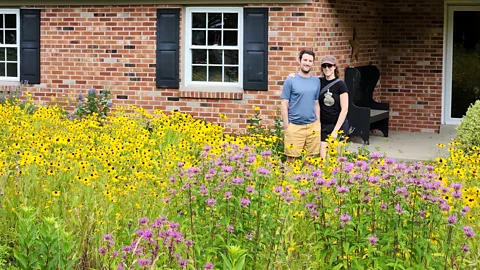 Sara Weaner Cooper
Sara Weaner CooperTurning lawns into meadows can have big benefits for people, wildlife and the climate. Here's why 'meadowscaping' has become the latest gardening craze.
When Sara Weaner Cooper and her husband bought their first home in Pennsylvania, they knew they didn't want a perfectly manicured front lawn like their neighbours. They wanted something that was more than just turf – a flourishing, wild meadow home to diverse species of plants and animals.
It was a bold plan, to be sure, considering it involved overhauling their entire lawn when they were new to the neighbourhood. Thankfully, Weaner Cooper had ideal support for the project – her father is Larry Weaner, a renowned ecological landscape designer (she is now executive director of the educational arm of his design firm). The landscape design style he uses relies predominantly on native plants, she says, aiming to work with how they want to grow rather than forcing them into particular areas.
She grew up with a non-traditional garden curated by her father, which she remembers as a "woodland wonderland" because it was designed to support large trees. Today, it's still heavily wooded and teems with other native plants that prefer a shadier plot (his property gets less light than the Coopers'). Her father didn't plot it out or plant very much, she says, but did "intentionally engage with it", encouraging what it seemed to want to do.
Weaner Cooper had always wanted to focus on native plants in her lawn and do less mowing, so rewilding their front lawn felt like the right move. But the Coopers' lawn is a different animal than her father's. It's in full Sun and consisted of over 1,500 sq m (16,000 sq ft) of turfgrass – narrow-leaved grasses designed to look uniform that had to be dealt with before a meadow could fully take over. Rather than rip everything up and live with a drab, brown lawn for months, they decided to try strategically seeding and planting native plants into the existing turf, hoping it would eventually weed the turf out naturally.
"It's easier in the sense that you don't need to be beating back as many weeds," explains Weaner Cooper. "[The native plants] came in so thickly that [they] outcompeted a lot of the weed pressure that would have been there if we would have just made it brown."
It took about two years, lots of planning, some careful weeding, and some trial and error, but eventually a medley of waist-high native plant species blanketed their vast front lawn.
 Sara Weaner Cooper
Sara Weaner Cooper"Meadowscaping", or turning a traditional lawn into a meadow, is a burgeoning trend experts in the field are noticing, especially among younger generations who tend to be more climate-aware than their predecessors. Compared to lawns, meadows – open landscapes filled with an array of non-woody plants such as tall grasses, flowers and herbs – are less expensive to maintain, require less water and energy and help sequester more CO2. Most importantly, they also encourage biodiversity and they're typically more appealing to pollinators, which are keystone species on which ecosystems depend.
Climate change and habitat degradation are leading to major losses of native species in ecosystems worldwide, which in turn can disrupt how those ecosystems function. Meanwhile, lawns cover about 23% of the US's urban land areas and 70 to 75% of open green space in cities worldwide. The more people who rewild their lawns, the more significant the environmental impacts that could be seen, from lower pollution and stormwater runoff to a reduction in soil erosion and urban heat island effects, all while improving local biodiversity and soil and groundwater quality.
But meadowscaping isn't as simple as only locking your mower away (sorry, NoMoMay). There are methods to meadowscaping, and they aren't always the most intuitive, especially for beginners. To help others get started, Weaner Cooper's landscape design firm developed an online course taught by her father that walks interested parties through the steps, from interweaving aesthetics and ecology to addressing practical garden issues.
One of the most common questions from participants in the course, Weaner Cooper says, is, "How should I handle my neighbours who might not appreciate how my meadow looks while it's in progress?"
Carbon Count
The emissions from travel it took to report this story were 0kg CO2. The digital emissions from this story are an estimated 1.2g to 3.6g CO2 per page view. Find out more about how we calculated this figure here.
She used a clever solution for her own property: a sign in her garden that reads "native meadow in progress". "I put my email, and I was just, like, 'ask me questions,'" she says. No one reached out directly, but cars sometimes stopped to take pictures.
In fact, Pennsylvania is one of a handful of states actively encouraging homeowners to transition their lawns to meadows. In 2020, the Pennsylvania Department of Natural Resources started a lawn conversion programme that in some cases helps finance meadow projects.
"They cannot keep up with the demand," says Shishir Paudel, a plant ecologist at the Phipps Conservatory in Pittsburgh, Pennsylvania. "It started in the eastern part of Pennsylvania, and it [was] so successful that they expanded into western Pennsylvania last year."
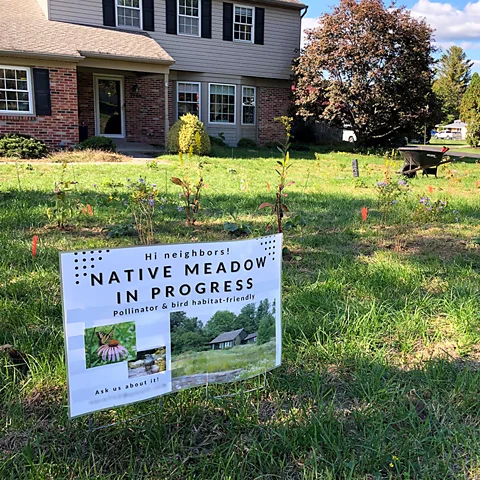 Sara Weaner Cooper
Sara Weaner CooperPaudel and his colleague Sarah States, director of research and science education at the Phipps Conservatory, spent the last six years studying the differences in environmental impacts between traditional and meadowed lawns. He hopes the metrics they collected will help convince more people to convert their lawns. But it's the financial disparity that he thinks may turn the most heads: as well as being cheaper to set up than a conventional lawn, a seeded meadow is far more affordable to maintain.
"You are likely to spend more than seven times more to manage one hectare of traditional lawn compared to meadow," says Paudel.
Maintaining a meadow also typically involves less work than regularly mowing a traditional lawn, but it's not completely hands off. "Every couple of weeks in the peak season I go out and trim things back, or mow the paths through the meadow," says Weaner Cooper. "And it looks very intentional."
An organised meadow
Still, meadowscaping doesn't have to look as wild as the Coopers' lawn. Take Marc Johnson's meadow in Toronto, Canada. A professor of biology at the University of Toronto, Mississauga, his research on how urban landscapes impact plant-pollinator interactions inspired him to create various pollinator gardens within his front yard (and label them accordingly).
Initially, his house had a "pristine" traditional lawn that the previous owner had maintained using lots of pesticides. Johnson did away with the pesticides and took a staged approach to his meadowscaping. Unlike the Coopers, he focused on creating specific smaller pollinator gardens within his yard. He also primed the lawn somewhat differently, clearing away much of the existing turf, putting down new soil, and then planting a large portion of native perennials, plants that come back year after year.
"And so, one garden at a time, we started to convert that space into pollinator gardens of different themes and flavours," says Johnson. "We just gradually took up the entire lawn."
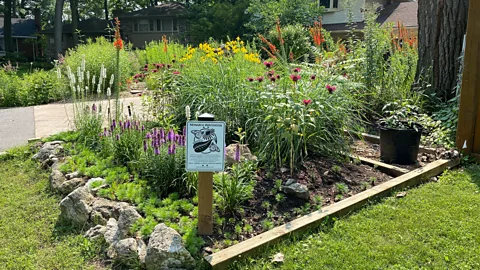 Marc Johnson
Marc JohnsonPollinator populations worldwide have declined precipitously over the last few decades. Monarch butterflies have been particularly impacted, and in just the last 20 years, the US has lost one-fifth of all its butterfly populations. But within the first year of his lawn conversion, Johnson says he began to see pollinators arriving to his flowering plants.
"You start to see pollinators that you have never seen in your yard before, and you didn't even know were in the area," he says. "One of the favourites for the bees and the butterflies would be purple coneflower. It is a very hardy, easy-to-grow perennial that's very common in gardens. I'd say it's one of the best species for people to start with."
Starting your own meadow
There are several ways to meadowscape a lawn, and what works on one property might not on another.
Still, experts agree you should aim for mostly native plant species (above 70% is often cited), with the ideal plants varying based on location. Johnson suggests finding a reputable nursery and asking them which are easy to grow and likely to come back.
He also recommends starting small. "Even creating a diverse little garden on an apartment balcony can have an impact," he says.
If you're looking for a quicker turnaround, you can remove the lawn with natural lawn and weed killer, such as white vinegar, or pull it up and start from scratch, says Weaner Cooper. It's more intensive, and you'll have a brown lawn for a time, but it'll give your new native species more room and fresher soil to grow.
As the various gardens on his lawn grew taller, Johnson's neighbours began asking questions, mainly about how they could do the same on their properties, he says – and none complained about his lack of lawn. After about two years, the whole yard transformed into a patchwork quilt of gardens. One section is entirely dedicated to evening primroses, a plant of particular biological interest to Johnson.
Johnson describes his lawn as his own version of a national park. It's frequented by hummingbirds, endangered monarchs, and various species of bees, he says, which he even built a bee hotel for – although it's not intended to house honeybees, he says, which are not a native species in North America.
"[The holes in the wood] are for the more diverse and ecologically important solitary bees, most of which are native," Johnson explains. "There are many different species that are nesting in there right now. And they are coexisting, although they are competing. It's not necessarily a happy time, but there is a lot of diversity in that one location."
Johnson's yard certainly involves some upkeep, especially as he tries to maintain the themes of his specific gardens, but he also recognises its need to evolve. "Every year is different because the species are competing. If something gets really abundant, sometimes a pathogen will come in and wipe it out, and then other things start to come in."
This natural cycling of species is part of what makes meadows more resilient. Plant and animal species may compete from time to time, but that's an element of a healthy ecosystem that encourages natural selection and adaptation.
The resilience of meadows
A recent study at King's College at the University of Cambridge in the UK, which measured the effects of rewilding half of the college's 300-year-old lawn, saw similar ecological benefits to meadowscaping. It found the meadow side was more climate resilient than the traditional side of the lawn, reflecting away 25% more sunlight, which helps protect the inhabitants from heat damage.
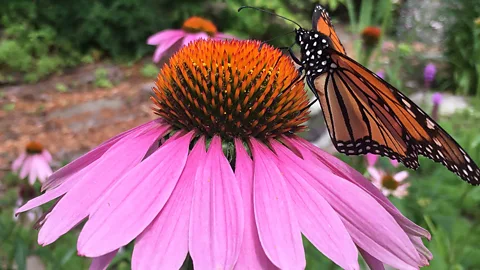 Marc Johnson
Marc JohnsonPlants typically found in meadows also tend to be more deep-rooted and, thus, more drought-tolerant. This makes them ideal for drier areas or those with limits to water consumption. What's more, their roots can help prevent stormwater runoff and even improve groundwater quality.
"In those diverse systems with the deep roots, [water] makes its way down into the bottom of the soil and then into the groundwater system," says Paudel. "At the same time, it's filtered through [the vegetation] when it goes into the groundwater, so the water becomes fresher, less polluted."
Xeriscaping, or meadowscaping with predominantly drought-tolerant plants, has been a water-saving practice in the American West for over 80 years. Government agencies that help landowners implement the practice have seen strong results: 18,000 properties in Southern Nevada, for example, saw an overall 30% reduction in annual water use and a 54% reduction in water costs after converting their turf landscapes to xeriscapes.
Similar plants can mitigate stormwater runoff, so Johnson planted some in a ditch on his property that was prone to flooding, creating a bioswale – a shallow trench designed to slow runoff with plants that help absorb the water into the ground.
More like this:
• Meet Siku, the itchy polar bear: How allergies are affecting animals
• Resurrection plants: The drought-resistant 'zombie plants' that come back from the dead
• Elephants hate bees – here's why that's good news for Kenyan farmers
"We put in plants that are especially adapted to wetlands but can also survive dry periods," he says.
The plants help stormwater runoff by rapidly sucking up water, both storing it in their leaves and using it for evapotranspiration, whereby plants release water to the atmosphere through the stomata in their leaves as they bring in CO2 for photosynthesis. "When I put water at one end of the ditch, by the time it got to the right-hand side of that, most of the water is gone," says Johnson.
Large-scale bioswales are even being implemented in cities like New York City to reduce flooding from sewer overflows and stormwater, which can pollute nearby bodies of water.
Doing the heavy lifting (lawn turnover and initial planting) of meadowscaping is easier during the winter months, when most lawns are dormant anyway – a process called winter sowing. Melanie Rekola, a horticulturist and professional landscape designer in Canada, did just this.
"We scraped away all the sod with machinery, and then we put down a little bit of soil, and I got a 100% native wildflower mix and we spread it," she says. "You spread it in the fall after a couple of frosts. Then all winter, those seeds get their cold stratification [exposure to cold, damp air that helps it germinate when it gets warm again] and the moisture they need, and then they come up in springtime, like they've always been there."
As the Coopers demonstrated, however, you don't need to remove everything from your lawn to plant a meadow. Paudel suggests a process called solarisation, where you cover your lawn with clear plastic in the summer, which traps heat and kills the turf. "In one week, grass will die, and then you plant, deliberately," he says.
Still, meadowscaping does have its limitations, one of the biggest being invasive species, which can overtake the native plants in a meadow if you don't keep an eye out for them. "Keeping up with the weeding does take a little bit of time, like they don't know where the border of [a] garden is," says Johnson.
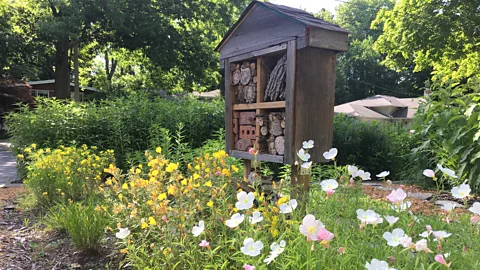 Marc Johnson
Marc JohnsonMeadowed lawns have been shown to have notable health benefits and may even reduce the amount of air and sound pollution that enters your home. Paudel says even roadside vegetation acts as a physical barrier and filter: "Vegetation holds air particles. If you live roadside and have tall plants, less air pollution will enter your house." Surrounding yourself with nature is also linked to reduced pain, improved cognitive function and restored attention and executive functioning in children and adolescents.
"It's a mental health booster. You look out your window in the spring, summer, fall, and almost every day, it's changing and it's beautiful," says Weaner Cooper.
And while it takes a fair amount of intentional curating, those who've rewilded their lawns seem to feel something beyond pride; rather more of a reverent stewardship of their local ecosystem.
"Imagine if half of an urban population took that view," says Johnson. "We could dramatically change our ecosystems for the better, making cities much healthier environments."
--
For essential climate news and hopeful developments to your inbox, sign up to the Future Earth newsletter, while The Essential List delivers a handpicked selection of features and insights twice a week.
